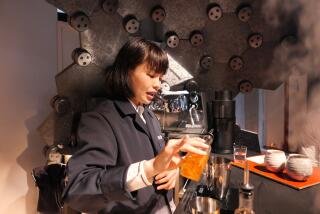Japanese Learn to Replace ‘Kampai!’ With ‘No, Thanks’
- Share via
TOKYO — In the intricate knot of alleyways behind Tokyo’s Shimbashi train station, businessmen stagger out of dilapidated bars with names like The Soul of Drunkenness and Oblivion. Neon casts an eerie light on one man bent double, retching, in the middle of the street.
That Japan likes a drink is clear to any pedestrian out after dark. But the country’s drinking habits may be more serious than society is willing to admit, judging by the growing health and economic costs of its love affair with the bottle.
“Japan takes an extremely indulgent attitude toward alcohol abuse,” says Hideo Hosaki, a professor of medicine at Tokyo’s prestigious Keio University.
Amid a worldwide trend of falling alcohol intake, Japan was the only leading industrialized country to see per capita consumption steadily rise over the ‘70s and ‘80s, the Health and Welfare Ministry reported in 1992.
The ministry hasn’t compiled more recent statistics, but figures from other sources indicate consumption may be stabilizing at the higher levels.
Japan’s average alcohol consumption is roughly equal to the United States’ at 1.74 gallons a year per person, according to government statistics. But officials say that figure is cause for concern because studies indicate nearly half of all Japanese lack an enzyme essential to breaking down alcohol in the body and thus suffer more damage from liquor.
Measured in terms of efficiency, medical fees, accidents and absenteeism, the cost is more than $60 billion a year, the health ministry estimates. About 17% of people hospitalized in Japan suffer from alcohol-related illnesses.
Japanese society has long tolerated--even encouraged--public displays of inebriation.
Buying a beer is as easy as slipping a coin into one of the ubiquitous alcohol-vending machines clustered in residential areas across the country.
“Drinking heavily on a daily basis isn’t seen as a problem until it’s too late,” says Tsukasa Mizusawa, a spokesman for ASK, a citizen-awareness group on alcohol abuse.
While private clinics and Alcoholics Anonymous are slowly gaining a foothold, alcoholism usually isn’t diagnosed until the drinker develops severe mental disorders or a life-threatening disease.
“There are very few doctors with the expertise to treat alcoholism,” says Hosaki, the medical professor. “Most doctors completely ignore the problems alcoholism can cause in the family and in society.”
The most common treatment for alcohol dependency in Japan is simply to commit late-term alcoholics to mental institutions.
Advocating temperance is almost considered antisocial because liquor plays a crucial role in forging bonds in Japanese society.
Every April, new company recruits are pressured into performing what is only half-jokingly described as their first duty as employees: drinking until they drop at company parties.
After-hours drinking turns Japan’s corporate structure upside down, providing relief from the rigid hierarchy. Subordinates are often allowed to criticize their bosses. Loud, outrageous behavior discouraged in sober states is indulged and sometimes admired if the offender has been drinking.
You may never need to fill your own glass. Drinking partners take turns pouring for each other--and refusing a refill is taken as rude.
The media, meanwhile, glamorize heavy drinking and play down its hazards.
When the late screen star Shintaro Katsu lit up a cigarette and downed a beer at a news conference to discuss his throat cancer, journalists erupted in laughter. The general attitude: What a guy.
Months later, Katsu was dead.
Ads for liquor flood prime time television--and frequently appear to be aimed at women and younger drinkers. Drinking in both of those groups is rising rapidly. A slew of new beer brands, including one called First Lady, directly capitalize on the surge in alcohol consumption among women.
The Health and Welfare Ministry’s 1992 study of alcohol abuse found the number of women who consider themselves drinkers surged from 19.2% in the late 1960s to 43.2% by the late ‘80s. Twelve percent of women ages 30 to 50 said they consumed alcohol every day.
“The Japanese love to drink,” says Hideaki Hattori, who has sold newspapers outside Shimbashi Station the last three years.
It’s evident every night around closing time, he says. “You see fights all the time.”
More to Read
Sign up for Essential California
The most important California stories and recommendations in your inbox every morning.
You may occasionally receive promotional content from the Los Angeles Times.













